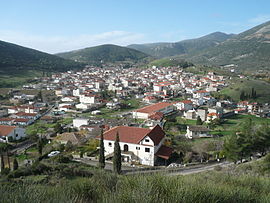Distomo
|
Distomo Δίστομο |
||
|---|---|---|
 |
||
|
||
| Coordinates: 38°26′N 22°40′E / 38.433°N 22.667°ECoordinates: 38°26′N 22°40′E / 38.433°N 22.667°E | ||
| Country | Greece | |
| Administrative region | Central Greece | |
| Regional unit | Boeotia | |
| Municipality | Distomo-Arachova-Antikyra | |
| • Municipal unit | 131.27 km2 (50.68 sq mi) | |
| Elevation | 218 m (715 ft) | |
| Population (2011) | ||
| • Municipal unit | 3,881 | |
| • Municipal unit density | 30/km2 (77/sq mi) | |
| Community | ||
| • Population | 3,192 (2011) | |
| • Area (km2) | 80.498 | |
| Time zone | EET (UTC+2) | |
| • Summer (DST) | EEST (UTC+3) | |
| Vehicle registration | ΒΙ | |
| Website | http://www.daa.gov.gr | |
Distomo (Greek: Δίστομο) is a town in western Boeotia, Greece. Since the 2011 local government reform it is part of the municipality Distomo-Arachova-Antikyra, of which it is the seat and a municipal unit. The municipal unit has an area of 131.270 km2, the community 80.498 km2. Population 3,881 (2011). Distomo is situated in the western foothills of Mount Helicon, at about 450 m elevation. It is 5 km north of the Gulf of Corinth coast, 9 km southeast of Arachova, 12 km east of Desfina, 16 km southeast of Delphi, 18 km west of Livadeia and 105 km northwest of Athens. The Greek National Road 48 (Naupactus - Arachova - Livadeia) passes north of the town.
Distomo is known as the site of the Distomo massacre that was perpetrated by the German army against the local inhabitants during the Second World War. One of the most important monuments of Byzantine architecture, the monastery of Hosios Loukas, is situated close to Distomo. The aluminum producing company Aluminium of Greece has its production facilities in the coastal village Agios Nikolaos. Other industries include agriculture and services.
The municipal unit Distomo is subdivided into the following communities (constituent villages in brackets):
On 10 June 1944, Distomo was the venue for a massacre by the Germans. Massacre of civilians constitutes a war crime. It was meant as "retribution" for the previous death of three Germans at the hands of local guerrillas, even though the villagers had no relation to the guerrillas.
...
Wikipedia



